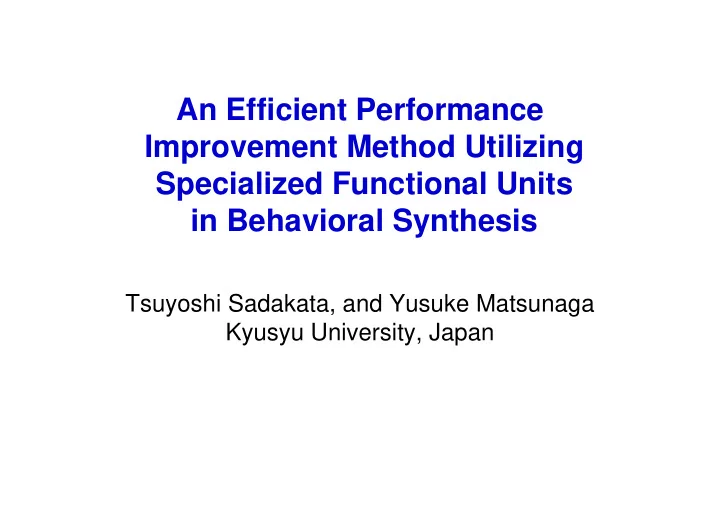

An Efficient Performance Improvement Method Utilizing Specialized Functional Units in Behavioral Synthesis Tsuyoshi Sadakata, and Yusuke Matsunaga Kyusyu University, Japan
Motivation • Specialized Functional Units (SFUs) (e.g. Multiply-Acc umulator) can be designed for specific operation patterns to achieve shorter delay and/or smaller area than casc aded basic functional units (e.g. Multiplier & Adder) • Introducing SFUs into behavioral synthesis can improve synthesis results • Because SFUs are less flexible for resource sharing , utilizing Specialized Functional Units in behavioral synth esis considering performance and area trade-off is a co mplicated problem 2
Related Works • Integer Linear Programming based Methods – Landwehr et al, ``Oscar: optimum simultaneous schedulin g, allocation and resource binding based on integer progr amming’’, EuroDAC94 – Marwedel et al., ``Built-in chaining: Introducing complex c omponents into architectural synthesis’’, ASPDAC97 Long computational time can be required for large problems • Heuristic Methods – Corazao et al., ``Performance optimization using template mapping for datapath-intensive high-level synthesis’’, IEE E Trans. on CAD96 – Bringmann et al., ``Cross-level hierarchical high-level synt hesis’’, DATE98 3 Maximizing performance ignoring the increase of resources
Proposed Method • A heuristic method utilizing SFUs for a simultaneo us Module Selection, Functional Unit Allocation, an d Scheduling problem considering performance /a rea trade-off – Constraint: clock cycle time & total functional unit area – Objective: minimize # of clock cycles – Approach 1. enumerate several feasible solutions at Module Selection 2. solve other sub-problems for each solution of Module Selection • Main Contribution Proposal of a novel heuristic Module Selection algorithm to restrict enumerated solutions effectively 4
Module Selection Sub-Problem • Enumerate several feasible Module Set Vectors satisf ying clock cycle time & total functional unit area constra int Module Set Vector (MSV) = K ( , , , ) msv n n n 1 2 | FU | : a set of functional unit types FU : selected # of th functional unit type n i i [ ] : notation for th element ( ) msv i i n i Feasible Module Set Vector (FMSV) • Synthesis target can be implemented with the msv • The msv satisfies given constraint Inclusion Relation between MSVs ′ ⇔ is included in msv ms v 5 ∀ ′ = ≤ L 1 , 2 , , | |, [ ] [ ] i FU msv i ms v i
Proposed Module Selection Algorithm • Only maximal FMSVs are enumerated – maximal FMSV: no other FMSV includes the msv Only FMSVs close to constraint boundary border are enumerated • maximal FMSVs are divided into several groups based on unit FMSVs = ⎧ 0 ( [ ] 0 ) msv i – unit FMSV: = maximal ⎨ [ ] msv i ≥ unit ⎩ 1 ( [ ] 1 ) msv i maximal For each group, minimum # of cycles is estimated with only unit FMSV # of cycles From a unit FMSV Estimated Result obtained by with the best value As Soon As Possible estimated value, Scheduling constant number of Total area of unit maximal FMSVs are FMSV 6 enumerated Total area Constraint
Experiment • Effect of utilizing SFU is evaluated in two ways – ALL: a heuristic method that enumerated all maximal FMSVs – OUR: a heuristic method with the proposed algorithm • Synthesis Target – bdist2(# of operations: 43, MediaBench:MPEG2 Encoder) – fdct(# of operations: 138, MediaBench:JPEG Encoder) • Functional Unit Library – Basic functional units (e.g. adder, multiplier) – SFU • Carry-Save Adder based construction algorithm for addition based o perations (provided by Synopsys Module Compiler) – All units were synthesized with Synopsys Module Compiler unde r maximum delay constraint 3 ns or 6 ns with a cell library for HIT ACHI 0.18um CMOS process technology provided from VDEC • Constant number for the enumeration of maximal FMSV s with the proposed algorithm – 1,000 7
Experimental Results # of clock cycles # of clock cycles (bdist2, clock cycle time constraint: 6ns) (fdct, clock cycle time constraint: 6ns) 80 35 The result cannot be The result can be obtained without SFUs obtained with SFUs 70 30 60 25 50 # of cycles # of cycles 20 40 15 30 10 20 OUR with SFUs: OUR with SFU: 5 10 ave. 17.5%, max. 35.7% reduction ave. 10.4%, max. 15.9% reduction 0 0 120000 130000 140000 150000 160000 170000 180000 190000 200000 210000 220000 110000 120000 130000 140000 150000 160000 170000 180000 Total area constraint (um^2) Total area constraint (um^2) ALL without SFUs ALL with SFUs ALL without SFUs ALL with SFUs OUR without SFUs OUR with SFUs OUR without SFUs OUR with SFUs Computational Time Comparison ALL with SFUs: max. 7,588 sec (bdist2), max. 8,218 sec (fdct) 8 OUR with SFUs: max. 149 sec (bdist2), max. 857 sec (fdct)
Conclusion • An efficient performance improvement method ut ilizing SFUs is proposed • Performance improvement under clock cycle tim e and total functional unit area constraint can be achieved in practical time with the proposed met hod • Experimental results show that utilizing specializ ed functional units has achieved 13.3% on avera ge, maximally 35.7% reduction of # of clock cycl es within 15 minutes 9
10 Thank you for your attention.
Recommend
More recommend